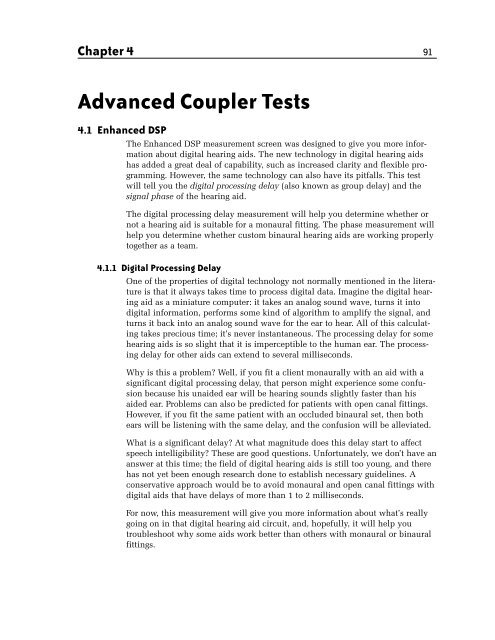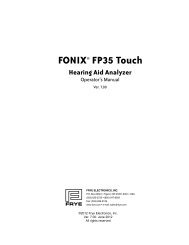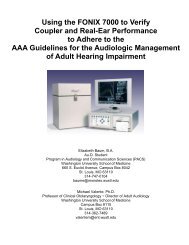FONIX® 8000 - Frye Electronics
FONIX® 8000 - Frye Electronics
FONIX® 8000 - Frye Electronics
Create successful ePaper yourself
Turn your PDF publications into a flip-book with our unique Google optimized e-Paper software.
Chapter 4 91<br />
Advanced Coupler Tests<br />
4.1 Enhanced DSP<br />
The Enhanced DSP measurement screen was designed to give you more information<br />
about digital hearing aids. The new technology in digital hearing aids<br />
has added a great deal of capability, such as increased clarity and flexible programming.<br />
However, the same technology can also have its pitfalls. This test<br />
will tell you the digital processing delay (also known as group delay) and the<br />
signal phase of the hearing aid.<br />
The digital processing delay measurement will help you determine whether or<br />
not a hearing aid is suitable for a monaural fitting. The phase measurement will<br />
help you determine whether custom binaural hearing aids are working properly<br />
together as a team.<br />
4.1.1 Digital Processing Delay<br />
One of the properties of digital technology not normally mentioned in the literature<br />
is that it always takes time to process digital data. Imagine the digital hearing<br />
aid as a miniature computer: it takes an analog sound wave, turns it into<br />
digital information, performs some kind of algorithm to amplify the signal, and<br />
turns it back into an analog sound wave for the ear to hear. All of this calculating<br />
takes precious time; it’s never instantaneous. The processing delay for some<br />
hearing aids is so slight that it is imperceptible to the human ear. The processing<br />
delay for other aids can extend to several milliseconds.<br />
Why is this a problem? Well, if you fit a client monaurally with an aid with a<br />
significant digital processing delay, that person might experience some confusion<br />
because his unaided ear will be hearing sounds slightly faster than his<br />
aided ear. Problems can also be predicted for patients with open canal fittings.<br />
However, if you fit the same patient with an occluded binaural set, then both<br />
ears will be listening with the same delay, and the confusion will be alleviated.<br />
What is a significant delay? At what magnitude does this delay start to affect<br />
speech intelligibility? These are good questions. Unfortunately, we don’t have an<br />
answer at this time; the field of digital hearing aids is still too young, and there<br />
has not yet been enough research done to establish necessary guidelines. A<br />
conservative approach would be to avoid monaural and open canal fittings with<br />
digital aids that have delays of more than 1 to 2 milliseconds.<br />
For now, this measurement will give you more information about what’s really<br />
going on in that digital hearing aid circuit, and, hopefully, it will help you<br />
troubleshoot why some aids work better than others with monaural or binaural<br />
fittings.
















